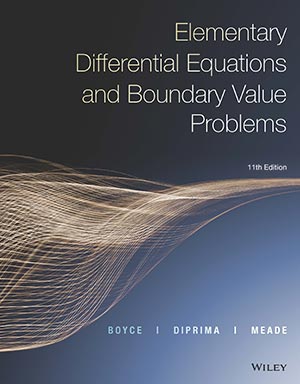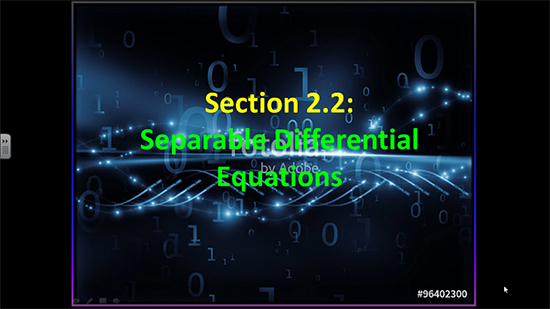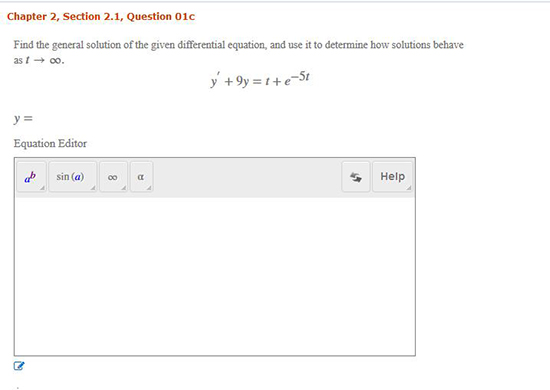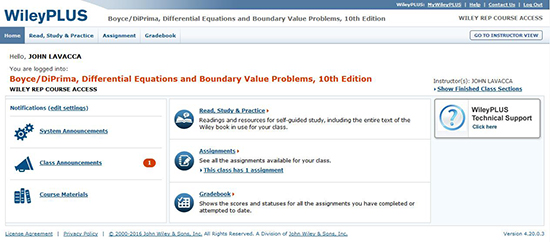
Elementary Differential Equations and Boundary Value Problems, 11th Edition
By William E. Boyce, Richard C. DiPrima, and Douglas B. Meade
The Eleventh Edition of Elementary Differential Equations and Boundary Value Problems includes new problems, updated figures, and additional examples to help motivate students.
WileyPLUS for Elementary Differential Equations and Boundary Value Problems is a research-based, online environment for effective teaching and learning.
Schedule a Demo Sign Up for a Test Drive Adopt WileyPLUSWant to learn more about WileyPLUS? Click Here

New videos inspire active learning.
Worked example video series has been included in WileyPLUS to provide students with clear, accurate, and pedagogically sound videos all in one place.

New WileyPLUS question type guides students through more difficult math.
Algorithmic Math Maple question types have been implemented to evaluate the more complex equations presented throughout the course.

Accessible course content helps students organize learning.
Students can access their eTextbook, homework, and practice problems from their tablet or computer anytime, anywhere.

William E. Boyce received his B.A. degree in Mathematics from Rhodes College and his M.S. and Ph.D. degrees in Mathematics from Carnegie-Mellon University. He is a member of the American Mathematical Society, the Mathematical Association of America, and the Society for Industrial and Applied Mathematics. He is currently the Edward P. Hamilton Distinguished Professor Emeritus of Science Education (Department of Mathematical Sciences) at Rensselaer. He is the author of numerous technical papers in boundary value problems and random differential equations and their applications. He is the author of several textbooks, including two differential equations texts, and is the coauthor (with M.H. Holmes, J.G. Ecker, and W.L. Siegmann) of a text on using Maple to explore Calculus. He is also coauthor (with R.L. Borrelli and C.S. Coleman) of Differential Equations Laboratory Workbook (Wiley 1992), which received the EDUCOM Best Mathematics Curricular Innovation Award in 1993. Professor Boyce was a member of the NSF-sponsored CODEE (Consortium for Ordinary Differential Equations Experiments) that led to the widely-acclaimed ODE Architect. He has also been active in curriculum innovation and reform. Among other things, he was the initiator of the “Computers in Calculus” project at Rensselaer, partially supported by the NSF. In 1991, he received the William H. Wiley Distinguished Faculty Award given by Rensselaer.

Douglas B. Meade received B.S. degrees in Mathematics and Computer Science from Bowling Green State University, an M.S. in Applied Mathematics from Carnegie Mellon University, and a Ph.D. in Mathematics from Carnegie Mellon University. After a two-year stint at Purdue University, he joined the mathematics faculty at the University of South Carolina, where he is currently an Associate Professor of mathematics and the Associate Dean for Instruction, Curriculum, and Assessment in the College of Arts and Sciences. He is a member of the American Mathematical Society, Mathematics Association of America, and Society for Industrial and Applied Mathematics; in 2016, he was named an ICTCM Fellow at the International Conference on Technology in Collegiate Mathematics (ICTCM). His primary research interests are in the numerical solution of partial differential equations arising from wave propagation problems in unbounded domains and from population models for infectious diseases. He is also well-known for his educational uses of computer algebra systems, particularly Maple. These include Getting Started with Maple (with M. May, C-K. Cheung, and G. E. Keough, Wiley, 2009, ISBN 978-0- 470-45554-8), Engineer’s Toolkit: Maple for Engineers (with E. Bourkoff and Addison-Wesley, 1998, ISBN 0-8053-6445-5), and numerous Maple supplements for numerous calculus, linear algebra, and differential equations textbooks — including previous editions of this book. He was a member of the MathDL New Collections Working Group for Single Variable Calculus and chaired the Working Groups for Differential Equations and Linear Algebra. The NSF is partially supporting his work, together with Prof. Philip Yasskin (Texas A&M), on the Maplets for Calculus project.
Richard C. DiPrima (deceased) received his B.S., M.S., and Ph.D. degrees in Mathematics from Carnegie-Mellon University. He joined the faculty of Rensselaer Polytechnic Institute after holding research positions at MIT, Harvard, and Hughes Aircraft. He held the Eliza Ricketts Foundation Professorship of Mathematics at Rensselaer and was a fellow of the American Society of Mechanical Engineers, the American Academy of Mechanics, and the American Physical Society. He was also a member of the American Mathematical Society, the Mathematical Association of America, and the Society for Industrial and Applied Mathematics. He served as the Chairman of the Department of Mathematical Sciences at Rensselaer, as President of the Society for Industrial and Applied Mathematics, and as Chairman of the Executive Committee of the Applied Mechanics Division of ASME.
In 1980, he was the recipient of the William H. Wiley Distinguished Faculty Award given by Rensselaer. He received Fulbright fellowships in 1964–65 and 1983 and a Guggenheim fellowship in 1982–83. He was the author of numerous technical papers in hydrodynamic stability and lubrication theory and two texts on differential equations and boundary value problems. Professor DiPrima died on September 10, 1984.
Chapter 1: Introduction
Chapter 2: First Order Differential Equations
Chapter 3: Second Order Linear Equations
Chapter 4: High Order Linear Equations
Chapter 5: Series Solutions of Second Order Linear Equations
Chapter 6: The Laplace Transform
Chapter 7: Systems of Linear Equations
Chapter 8: Numerical Methods
Chapter 9: Nonlinear Differential Equations and Stability
Chapter 10: Partial Differential Equations and Fourier Series
Chapter 11: Boundary Value Problems and Sturm-Liouville Theory

